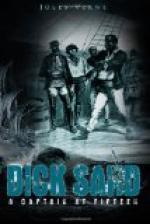* * * * *
CHAPTER XII.
ON THE HORIZON.
At that date the tempest took its most terrible form, that of the hurricane. The wind had set in from the southwest. The air moved with a velocity of ninety miles an hour. It was indeed a hurricane, in fact, one of those terrible windstorms which wrecks all the ships of a roadstead, and which, even on land, the most solid structures cannot resist. Such was the one which, on the 25th of July, 1825, devastated Guadaloupe. When heavy cannons, carrying balls of twenty-four pounds, are raised from their carriages, one may imagine what would become of a ship which has no other point of support than an unsteady sea? And meanwhile, it is to its mobility alone that she may owe her salvation. She yields to the wind, and, provided she is strongly built, she is in a condition to brave the most violent surges. That was the case with the “Pilgrim.”
A few minutes after the top-sail had been torn in pieces, the foretop-mast stay-sail was in its turn torn off. Dick Sand must then give up the idea of setting even a storm-jib—a small sail of strong linen, which would make the ship easier to govern.
The “Pilgrim” then ran without canvas, but the wind took effect on her hull, her masts, her rigging, and nothing more was needed to impart to her an excessive velocity. Sometimes even she seemed to emerge from the waves, and it was to be believed that she hardly grazed them. Under these circumstances, the rolling of the ship, tossed about on the enormous billows raised by the tempest, was frightful. There was danger of receiving some monstrous surge aft. Those mountains of water ran faster than the schooner, threatening to strike her stern if she did not rise pretty fast. That is extreme danger for every ship which scuds before the tempest. But what could be done to ward off that contingency? Greater speed could not be imparted to the “Pilgrim,” because she would not have kept the smallest piece of canvas. She must then be managed as much as possible by means of the helm, whose action was often powerless.
Dick Sand no longer left the helm. He was lashed by the waist, so as not to be carried away by some surge. Tom and Bat, fastened also, stood near to help him. Hercules and Acteon, bound to the bitts, watched forward. As to Mrs. Weldon, to Little Jack, to Cousin Benedict, to Nan, they remained, by order of the novice, in the aft cabins. Mrs. Weldon would have preferred to have remained on deck, but Dick Sand was strongly opposed to it; it would be exposing herself uselessly.
All the scuttles had been hermetically nailed up. It was hoped that they would resist if some formidable billow should fall on the ship. If, by any mischance, they should yield under the weight of these avalanches, the ship might fill and sink. Very fortunately, also, the stowage had been well attended to, so that, notwithstanding the terrible tossing of the vessel, her cargo was not moved about.




